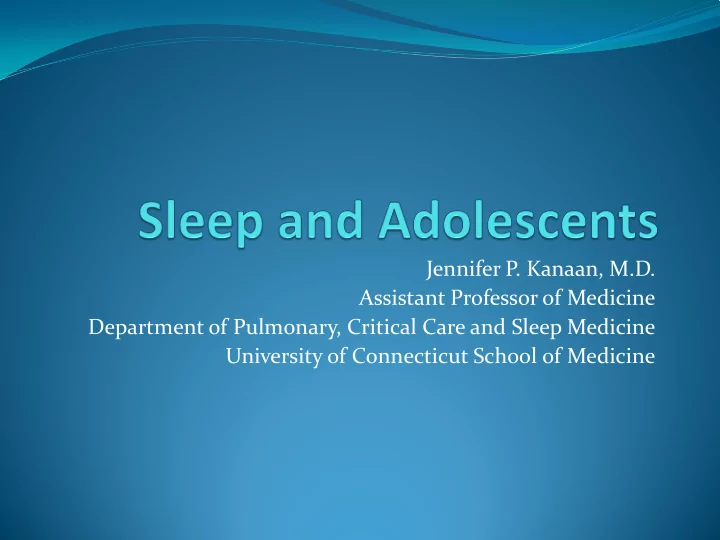

Jennifer P. Kanaan, M.D. Assistant Professor of Medicine Department of Pulmonary, Critical Care and Sleep Medicine University of Connecticut School of Medicine
What is a Normal Amount of Sleep? Preschool Child (3-5 yrs) 10-11 hours Elementary School Child (6-12 yrs) 10 hours Adolescent (>12yrs) 9-9.5 hours Adult 7.5-8
Sleep in Adolescents 6th- 8th grade adolescents 21% insufficient sleep 38% borderline amount of sleep 35% optimal amount of sleep 9 th -12 th grade adolescents 63% insufficient sleep 25% borderline amount of sleep 9% optimal amount of sleep NSF 2006 Sleep in America Poll
Changes to Adolescent Sleep Melatonin, sleep promoting hormone, is released later Teenager circadian rhythm is shifted up to 2 hour Adolescents have a longer internal day (24.27 hours) Slowed sleep drive Biologically teens are programed to wake later and go to bed later
Additional Changes in Adolescence Increased academic demands Increased societal demands Bedtime autonomy Screen time Social networking
Computers/Cell Phones Emit a blue wave length of light Suppresses melatonin release Can reset your internal clock Study of participants with LE-eBooks Longer to fall asleep Reduced melatonin secretion Reduced next morning alertness Reduced REM sleep Chang AM et al PNAS 2015 p1232-1237
The Perfect Storm Carskadon, M.A. Pediatr Clin North Amer 2011; 58(3) 637-47
Sleep Deprivation in Children More severely affected by sleep deprivation than adults Mood disturbances Irritability Emotional lability Depression Seven times more likely to attempt suicide in a study in Fairfax VA Anger
Prefrontal cortex (problem solving/decision making) is unable to communicate well with the amygdala (emotional center of the brain)
Sleep Deprivation in Children Memory problems Difficulty paying attention Difficulty with problem solving and decision making Somatic complaints Behavioral problems such as over activity, impulsivity Relationship problems
Insufficient Sleep and Weight Insufficient sleep increases ghrelin, cortisol and decreases leptin hormones Increased craving for high calorie, carbohydrate rich food Shortened duration of sleep is linked to obesity in children and adults Cappuccio FP et al Sleep 2008 p 619-626 Potential risk factor for Type 2 diabetes McNeil J et al CJD 2013 p 103-8.
Sleep Deprivation in Teens Teen drivers sleeping < 8 hours are 1/3 more likely to crash than those sleeping 8 or more hour. Hutchens L, et al. Teen Driver Crash Risk and Associations with Smoking and Drowsy Driving. Accident Analysis and Prevention . May 2008s Increase in risk taking behavior Increase in alcohol, substance abuse, cigarette use Johnson et. al. Drug Alcohol Depend, 64 (2001), pp. 1–7 Adolescents who sleep more than 8 hours have fewer athletic injuries
Sleep Deprivation and Academics Study of over 3,000 high school students Students describing themselves as struggling in school reported 25 minutes less sleep per night and bedtime of 40 minutes later compared to A and B students Reported greater weekend delay in sleep schedule Wolfson et al Child Dev 1998; 68(4):875-87 Study of college students revealed short sleepers had lower GPAs than long sleepers Kelly et al Coll Student J p84-6
What are the Effects of a Delayed Start Time?
School Start Time Longer sleep durations Upwards of 1 hour Bedtimes are similar Wahlstrom et al NASSP Bull 2002; p 3-21 Number of students reporting at least 8 hours of sleep increased from 16% to 55% Number of students with <7 hours of sleep fell by 79% Owens et al Arch Pediatr Adolsc Med 2010 p 608-614 Decreased daytime sleepiness and propensity to fall asleep during class
Academics There is a trend towards improved grades Wake County NC found an improvement in standardized math and reading scores by 3% points Letter grades increased in both Arlington County and Minneapolis Wheaton AG et al Journal of School Health 2016 p363-381 Cautionary Note Not all studies document an improvement in grades Results on standardized test scores are conflicting
School Start Times Lower depression scores Decrease in teen crash rates Two studies saw a decrease of 65% Improved attendance Wheaton AG et al Journal of School Health 2016 p363-381
National Recommendations American Academy of Pediatrics Policy Statement 2014 Urges school districts to aim for a delayed school start time American Medical Association 2016 American Academy of Sleep Medicine 2017 Recommends a delayed school start time Centers for Disease Control
Benefits of Delayed School Start Times Longer total sleep time Decreased risk of suffering depression Less likely to be involved in an MVA Improved reaction times Reduced tardiness and absences
Benefits of Delayed School Start Times Reduced obesity risk Increased engagement in class activities Potential for better grades Better quality of life
Benefits of Delayed School Start Times Improved physical and mental health Improved safety Athletic performance Potential for improved academic performance
Recommend
More recommend